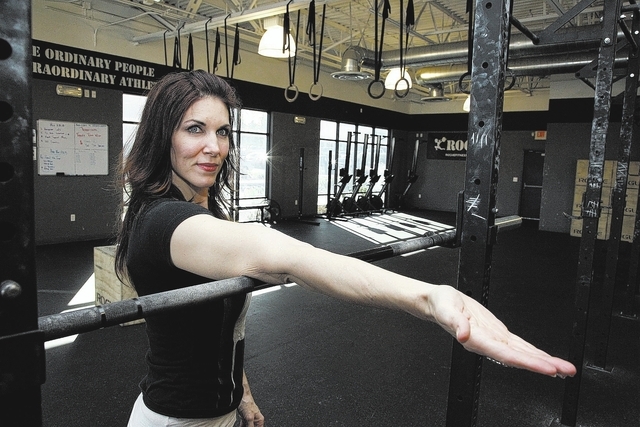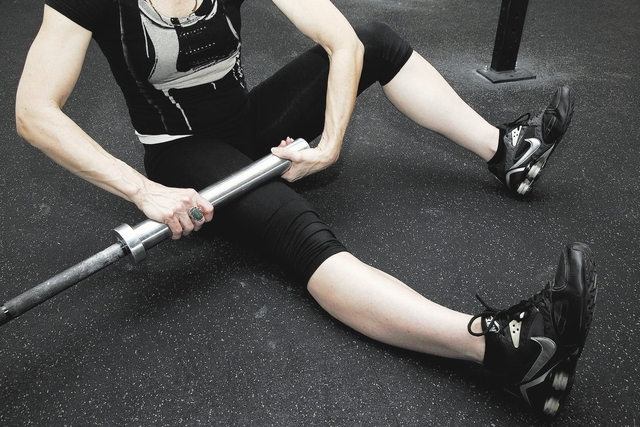Barbells work overtime as useful mobility tool




Barbells are a great tool for exercising. You can use them for squatting, dead lifting and pressing. Did you know that you can also use them as a mobility tool?
Yup, it’s true. You can use it in a similar way as the foam roller to perform self-myofascial release, or SMR. Foam rolling is an inexpensive way to help release myofascial adhesions, or knots, in various muscles. Using a cylinder of dense foam, you can find these trigger points and give them some manual therapy. In past columns I have covered how to roll most every major muscle group. Check them out online at www.lvrj.com/trainer.
Using a barbell is also an effective method to perform SMR. The weight of the bar is all the pressure you will need. There is no need to dig in with extreme pressure. Harder is not always better. The objective is to release tension and break up adhesions. Pressure that is too intense may have the opposite effect and cause the muscle to tighten up further.
When rolling with a foam roller or barbell it is important to never roll any joint. Rolling is for muscles, not bone and connective tissue. Rolling connective tissue could cause a callus that would reduce the feeling of pain. There is the possibility of desensitizing a tight area that you cannot feel is tight. This situation could lead to injury when doing lifts or sports.
Pain is a useful tool. It is your body’s way of letting your brain know when something is not right. Muscles that are tight cannot move correctly. This can lead to postural imbalances and injury. Instead of numbing the pain with pills, let’s release the muscle and get performance back.
When rolling, you are actively looking for “tender” areas. These tender spots are sites of adhesions. Research shows that pressure on these areas for 20 to 30 seconds can help break up adhesions. I like to use a pain scale from one to 10 when rolling. One is little to no pain and 10 is extreme. Areas that are an eight or nine can be reduced to a five or six after a few weeks. Performance in that muscle is sure to improve, including mobility and strength.
Be careful of areas that are too tender to touch. If you feel like tearing up then that spot is a little too tender. Don’t spend too much time there. Try rolling above and below that especially tender spot to reduce tightness around it and then revisit it. In my experience, quads and triceps can be some of the most tender areas when rolled.
To understand where to roll it is good to know a little anatomy. Here come some big words, but you don’t necessarily need to know the names, just the location so you can know where to roll. Your quadriceps complex is made up of four muscles. Looking down at your leg your rectus femoris is right in the middle. The “teardrop” to the inside of the leg is the vastus medialis. The one on the opposite side on the outside of the leg is the vastus lateralis. A little more to the outside of it is vastus intermedius.
In short, there is one muscle in the middle, one toward the inside of the leg and two on the outside.
Triceps are a bit easier. They insert at the same area in the forearm but have three origins at the upper arms and the scapula. To make it simple, there is one muscle in the middle of the back side of the arm and a muscle on ether side.
Be sure to give attention to each of the muscles in the quads and the triceps, because sports and other activities can make different muscles tighten up to varying degrees.
Rolling could potentially take some time. You need to stop on each trigger point for half a minute. Let’s hypothesize that you have three to four trigger points per muscle. Then it is recommended to make two passes on each of the seven muscles that make up the triceps and quads. Already, you have exhausted a good half-hour on a barbell without even lifting it. Roll the tightest muscles first on workout days. If you have a rest day, it is a good idea to roll everything that hurts on that day.
Chris Huth is a Las Vegas trainer. He can be reached at 702trainer@gmail.com. Consult your physician before beginning any exercise program.












